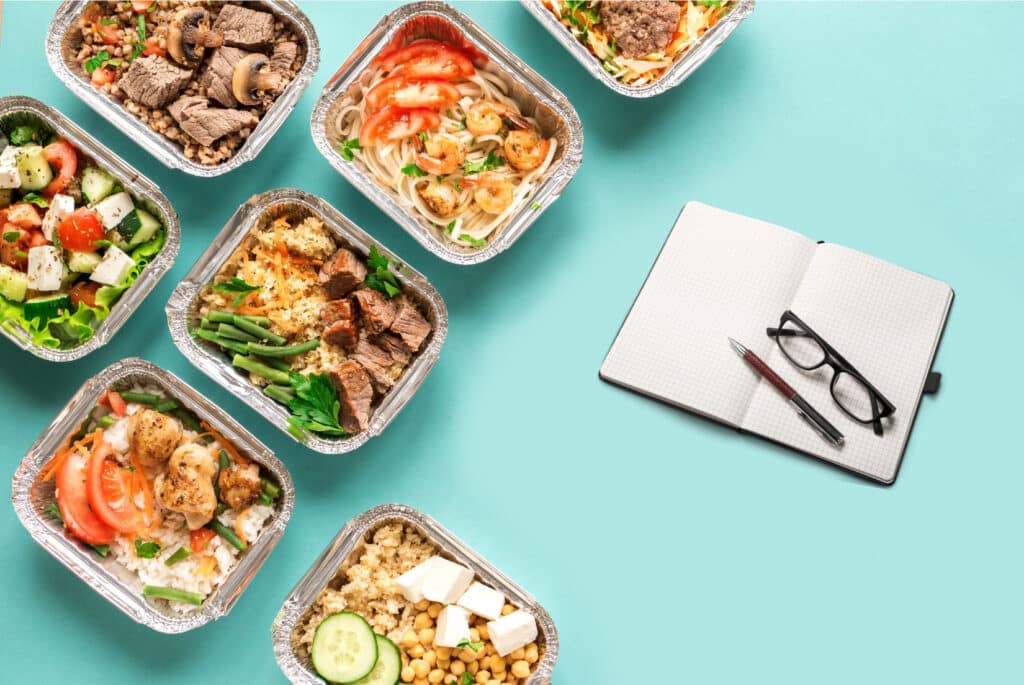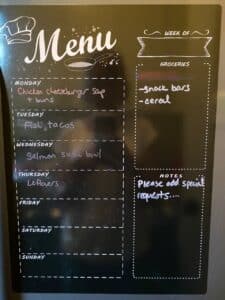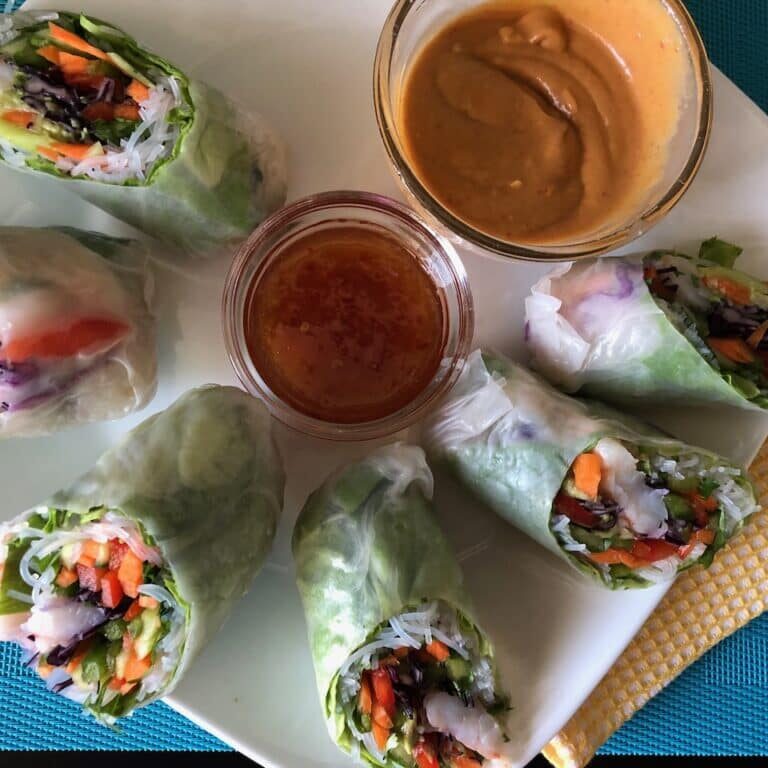Midlife meal planning: 9 tips to help you eat well in your chaotic life.
Meal planning. Meal plan. Nutrition plan. Food plan. Menu plan. Most of us know these help us, but many of us don’t make them. We’re too busy. We don’t know what to plan. It feels like a defeating process that we can’t stick to, so why bother?
Why bother? Because meal planning gives you an alternative to one of the most dreaded questions any of us ask at 5 o’clock. The question “What’s for dinner?” comes when we are exhausted, depleted, hungry, uninspired and everything we can think to eat is either still frozen or still at the grocery store, if we can think of anything at all. When people say they hate cooking, I think that part of what they hate is this experience.
How to eat well in a chaotic life
Call it what you want. I’ll refer to it as meal planning (maybe you have a descriptor that packages this process in a way that is less obtuse or that signals less drudgery?). Either way, meal planning is a lifesaving, health-promoting, money-saving, meal game-changer that can help you dread the 5 o’clock witching hour less and sprint to the finish line of your day. It also helps you find more satisfaction with your meals, so you aren’t foraging for food an hour after you have eaten.
By meal planning, I am not suggesting that you make a rigid and inflexible meal plan. And I am not suggesting some form of Martha Stewart-esque type of meal. I mean having a loose game plan of what 3-ish meals you plan to make during the week so that you can at least have some mealtime logistics sorted out…your chicken is thawed, you can use the bagged salad before it spoils, you have a game plan for making the cauliflower taste sweet and nutty so people will actually eat (and enjoy) it. The goal is to get personally acceptable and satisfying food on your dinner table.
By taking a few ahead-of-the-game steps, you will begin to reduce mealtime chaos, and start to create more ease in the kitchen with food. And your stressed-out body will thank you for it.
The key to successful meal planning when your life is chaotic
The main meal planning steps or sequence are plan – shop – cook (or assemble). Most people I work with find the planning process to be overwhelming and time-consuming. The key to successful meal planning is to implement the meal planning steps (plan, shop, cook) throughout your week, at different times so that you can take small steps, along the way. Hear me out.
The (loose) planning part in meal planning is *the most* critical step. Once you have a (loose) plan in place, the steps that follow are much simpler (and way less stressful). Below are some meal planning tips that will help you systematically spend time to save time, which will help create more ease at your meals.
9 Tips for midlife meal planning
1) Identify your current go-to meals
Your go-to meals are the ones you know how to make. These are the meals that come to mind when you ask yourself “what do I know how to make for dinner?” This might be tacos, spaghetti and meat sauce, chicken and rice or hamburgers. Work with the list you have. If you feel bored and uninspired, you may benefit from expanding this list.
Here is a link to my list of potential go-to meals that helps me with my meal planning process so I can have good-tasting food that makes my body feel great.
2) Use prompts for meal planning
When we are tired, stressed, or over-whelmed, most of us don’t have creative juices for food ideas that we would find appealing and within our current food skill set. Using prompts for meal-planning can help.
Think of prompts as sources for meal inspiration: recipe books or magazines, trusted recipe sites, your Pinterest board, your go-to meal list from number one above. Using your meal-planning prompts, you can quickly scan through a few trusted recipe sources to help you determine some meal options that appeal. You don’t even need to follow the recipe exactly. The prompt is purely that – to help give you an idea for what to make. You can decide if you want to adapt the recipe to suit your preferences.
3) Plan around an anchor food then balance your power plate from there. The anchor food is what you will plan your meal around. Maybe this is something you need to “use up” in your fridge or freezer. Or maybe it is a food you intentionally want to add more of, so it may require you to add specific foods to your grocery list.
From this anchor food, you can round out your plate with other foods that you have available in your home. Maybe your anchor food is a veggie-packed Bolognese sauce to which you add spaghetti noodles and some sliced cucumbers (two foods that I know I usually have in my kitchen). Run out of noodles? Maybe you serve your sauce with some cooked rice and some crunchy snap peas.
4) Plan your meals by where you will physically be during the witching hours The witching hours are between 4:30 – 6:00 pm in my house. Some meals take less than 15 minutes to make start to finish and are perfect for time-crunched weeknights (think stir fries or omlets). Other meals take 5-10 minutes of hands-on prep, and then 30-45ish minutes of cooking time (think sheet-pan meals). These meals can be perfect to make when you are going to be home for more than just 20 minutes. While the food is cooking, you can get changed, go out for a breath of fresh air.
Look ahead to your week – what time do you expect to get home? Will you be at home, or will you be running out to activities? How long will you be home before you need to leave again? Different weeknights require different meal-time strategies and can include 15-minute meal options, slow cooked meals, sheet-pan meals, freezer meals, meals that are already prepped, etc. Starting with a meal-forecast will help you decide the “type” of meal that would best serve your family in the next week.
Meal planning can also help you eat lunches when you are scheduled to be in meetings all day.
5) Support your meal plan with flexible back up options.
We all have days where things go sideways and our plan falls through the window. What is your back up plan for “emergencies”? ie – someone forgot to take out the chicken to thaw. Someone forgot to turn on the slow cooker. The strategy here is to have a few options for what to feed yourself, and then to have these foods or ingredients available in your kitchen as back up.
6) Meal plan in some “helper foods”.
Think of helper foods as adding in foods that are somewhat prepared for you. Ex: Frozen Asian Veggie mix, bagged salad, frozen un-breaded chicken burgers, pre-chopped broccoli, stir fry mix, etc. These are especially helpful for mid and late-week nights when our energy levels are starting to get low.
7) Think about meal planning around your health profile.
Whether you have a chronic illness, or parts of your health profile that requires support (think blood sugars, high cholesterol, mental health, GERD, joint health, etc), you may have therapeutic foods that you and your dietitian are working to increase in your diet. Translating your medical nutrition therapy into something actionable in your kitchen starts with meal planning.
Maybe you are adding in more omega-3 fats to support your cholesterol levels, in which case, you may be working to increasing your intake of fish, walnuts and/or flaxseed. You may be working to stabilize your blood sugars throughout the day, in which case, adding in a balance of protein, fueling carbohydrate and nourishing fats may be helpful to your meal plan for the week. Maybe you want to embrace the Mediterranean Diet as anchor to how you eat.
And while we can all throw together foods that meet the nutritional mark, we would actually enjoy those foods more if they also taste good! Planning is the way we elevate our meals from done to delicious.
8) Communicate your (loose) meal plan
Once you have created a (loose) meal plan, make sure this plan is documented and communicated. Take the work of remembering your plan out of your brain so you have room to think about other things. I bought this meal planning board off Amazon for $20 (#unsponsored).
9) Save your meal plans
Going through the meal planning process will get easier with weekly practice. This skill gets stronger, like a muscle, the more you practice and use it. Make sure to keep a copy of your meal plans (either written, typed up or digitized). This way, on the weeks when life is going at mach-10, you have previous plans to work from. Save this in your go-to list (see tip #1 above).
Plan your meal strategy throughout the week
The key to meal planning success is to implement the main meal planning steps (plan, shop, cook) throughout your week, at different times so that you can take small steps, along the way. One of my favourite strategies is to work with pockets of “dead time”.
Plan your meals during pockets of “dead time”
Dead time is when you are sitting, waiting, or not doing much. When my kids were younger and I watched their hockey practices, I would bring a bag of one or two cookbooks plus sticky notes where I could scan and identify recipes that looked simple and interesting for our week. Then, when it came to creating a general plan for the next week, I would pick from these meal ideas and from there I could make my grocery list. Busy people need strong strategies to minimize wasted time.
Instead of aimlessly scrolling through social media, take back five or ten minutes to do a bit of meal scanning. You could also pre-select some recipes while watching your favourite show on Netflix. Changing how you use your “down time” could help save your stress and overwhelm later in the week.
The planning step is the most challenging step in this process. Once you have some kind of general plan, you can translate your plan into action via your grocery list. Once you get into a rhythm with loose meal planning, you will likely find less chaos and more ease at this time of the day.
Need help with building habits that serve you? Click here.
Final thoughts about midlife meal planning
Supporting your midlife health with foods starts with the foods you routinely eat. Prepping food with less processed food ingredients is one of the most powerful things you can do for your body (I am not demonizing processed foods. We all eat them). If the meal planning process above feels overwhelming and daunting, it may be that you are out of practice. You can strengthen your kitchen and mealtime muscles with food practice and food skills. And there are many tools that can help. And there are professionals, including myself, who can also help you if you like.
Reflection questions to think about your midlife meal planning:
- What is working well in your meal planning?
- Where do things go sideways? Is it all times of the day or only certain times of the day. Where do you need support or more attention?
We cannot change what we don’t understand. Once we understand what we are working with, we can create a pivot with steps forward to help you stress-less at meals. And who isn’t hungry for that?!
Related articles
A Mediterranean Diet Meal Makeover showing how you can make small changes in your diet
The Mediterranean Diet: what is it, why it matters in midlife and 12 tasty food tips to get started
Tagged in: meal planning, menopause, midlife, midlife eating, midlife health, perimenopause
2 Comments
Leave a Comment


Welcome to the Energize Nutrition blog, where we share evidence-based nutrition content, designed to empower people’s midlife. Take a look around to find information on feeling your best.
If you need more individualized support, reach out to set up a free discovery call with Kristyn Hall.

Battling chronic hunger, poor energy, or inflammation? Discover what this powerful ingredient is and why it might be the solution!











So many useful tips in this post Kristyn! Thank you for sharing your advice and wisdom. I really like the idea of ‘loose’ meal planning, and just keeping it simple…plan – shop – cook.
You are so welcome Cathy! Meal planning does not have to be rigid or inflexible. The thought of that makes me shudder and feel boxed in. I checked my list of “loose meal ideas” this morning, and I felt immense relief knowing that I 1) have an idea of a few possibilities and 2) I have the ingredients I need for the idea. Tonite’s meal is now a matter of “execution”, which I have to do, with or without an idea. But this way is way less stressful… 🙂